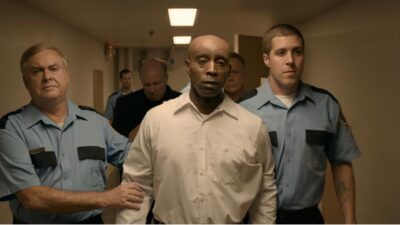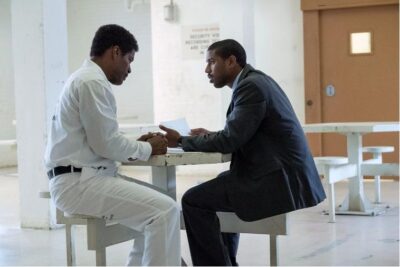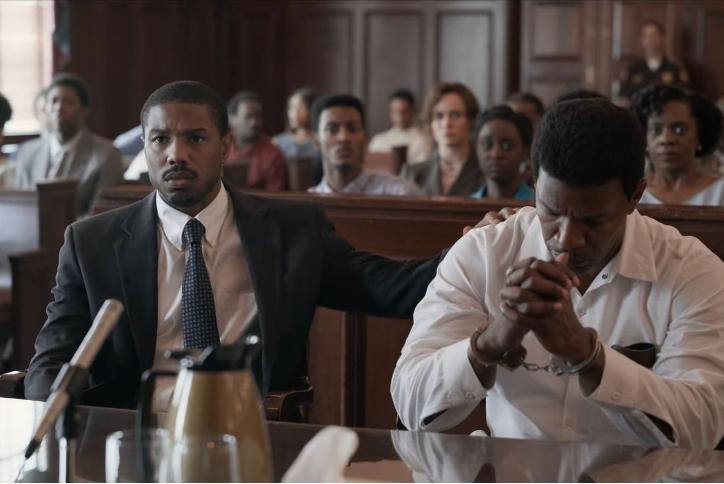Just Mercy : a movie about hope, redemption, justice and love
During his life, Stevenson established the Equal Justice Initiative (EJI) in Montgomery (USA) in 1989, a non-profit organization that provides legal representation to prisoners who may have been wrongly convicted of crimes, poor prisoners without effective representation, and others who may have been denied a fair trial, and it guarantees the defense of anyone in Alabama in a death penalty case. The EJI has subsequently saved 115 men from the death sentence. Stevenson has also petitioned successfully in the Supreme Court to end the legal incarceration of children as young as 13 to sentences of life without parole in adult prisons.
The movie, based on his story, offers a movingly matter-of-fact account of one man’s struggle to lend voice to the silenced, dispossessed inmates of death row, by framing its wider story of poverty, prejudice, and institutional racism.
Bryan Stevenson, portrayed by Michael B. Jordan, is a young black man from Delaware who graduates from Harvard Law. In 1987, he travels to Monroeville, Alabama, to join a white administrative director, Eva Ansley (Brie Larson), in an organization that provides death-row inmates with legal representation. The movie focuses on an early, pivotal episode in Stevenson’s career: the case of Walter McMillian (Jamie Foxx), nicknamed Johnny D, an African American condemned to death for a crime that he evidently did not commit. This case is not the whole picture; rather, it is a totemic example of how a socioeconomic system forged within the furnace of slavery still bears the shackles of its past.
In the course of his work, Stevenson discovers that the case is based on a complete fabrication of evidence by a white sheriff and a white prosecutor, unchallenged by a white public defender, unquestioned by a white judge, and accepted by an all-white jury.
The inmate, who has had prior appeals denied, is resigned to his fate. He does not want to reopen the case and reawaken hopes only to see them dashed again. But Stevenson is confident that, with his own local investigation of the evidence, he can bring an appeal to a higher court and have the conviction overturned.
McMillian has been arrested for the murder of white teenager Ronda Morrison in Monroeville. Billboards boast about Monroeville being Harper Lee’s hometown (“Check out the Mockingbird museum,” says Rafe Spall’s district attorney, “it’s one of the great civil rights landmarks of the south”), but the spirit of Atticus Finch does not appear to haunt these halls of justice.
From the start, the movie presents the obstacles that Stevenson and Ansley face in their efforts—social obstacles, rooted in racism, some of which are masked as impersonal official actions. Racism is at the very root of the story: the original case against McMillian was brought because he was hated by whites for having had an affair with a white woman. Stevenson and Ansley’s effort to rent an office is rejected by a white building manager on the grounds that their work will prove controversial. A white prosecutor arrests, on fabricated charges, a black man who is planning to offer testimony that would exonerate McMillian. Sometimes, the menace is physical and violent: when Stevenson arrives at the prison where McMillian is being held, he is subjected, illegally, to a strip search by a white guard; a bomb threat, laced with racist insults, is called in to Ansley’s home; and, while driving, Stevenson is pulled over by two white police officers who intimidate him, insult him, and hold a gun at his head.
 The drama is infuriating and devastating, because it clearly presents the agonies endured by those who are wrongly convicted and unjustly executed, as well as those suffered by their families and their community. The director, Destin Daniel Cretton presents touching scenes of solidarity and friendship among the death-row inmates, principally those in McMillians’s nearby cells: Herbert Richardson (Rob Morgan), a mentally ill Vietnam War veteran, and Ray Hinton (O’Shea Jackson, Jr.), a hearty young man who tries to keep his neighbors’ spirits up. Stevenson’s visit to the McMillian household, when he makes his pitch to the skeptical family to reopen the case, is the first of many scenes throughout the film that display the collective mobilization of Monroeville’s black residents on McMillian’s behalf, and their despair at the legally enshrined injustices that they must endure.
The drama is infuriating and devastating, because it clearly presents the agonies endured by those who are wrongly convicted and unjustly executed, as well as those suffered by their families and their community. The director, Destin Daniel Cretton presents touching scenes of solidarity and friendship among the death-row inmates, principally those in McMillians’s nearby cells: Herbert Richardson (Rob Morgan), a mentally ill Vietnam War veteran, and Ray Hinton (O’Shea Jackson, Jr.), a hearty young man who tries to keep his neighbors’ spirits up. Stevenson’s visit to the McMillian household, when he makes his pitch to the skeptical family to reopen the case, is the first of many scenes throughout the film that display the collective mobilization of Monroeville’s black residents on McMillian’s behalf, and their despair at the legally enshrined injustices that they must endure.
“Just Mercy” is a drama of immense power; its vision of the possibility of individual triumphs over systematic persecution is guardedly hopeful, and its depiction of the dysfunctional justice system itself looks ahead to the possibility of progress.
The movie touches the very thorny topic of capital punishment, highlighting the lack of hope that this punishment can bring to those who are condemned. Death penalty breaches human rights, in particular the right to life and the right to live free from torture or cruel, inhuman, or degrading treatment or punishment. Both rights are protected under the Universal Declaration of Human Rights, adopted by the UN in 1948.
Over time, the international community has adopted several instruments that ban the use of the death penalty, including the following: The Second Optional Protocol to the International Covenant on Civil and Political Rights, aiming at the abolition of the death penalty; Protocol No. 6 to the European Convention on Human Rights, concerning the abolition of the death penalty, and Protocol No. 13 to the European Convention on Human Rights, concerning the abolition of the death penalty in all circumstances; The Protocol to the American Convention on Human Rights to Abolish the Death Penalty.
Nevertheless, In the United States, capital punishment is a legal penalty throughout the country at the federal level, in 27 states, and in American Samoa. It is also a legal penalty for some military offenses. Although in some legal systems the use of the death penalty must be restricted to the most serious crimes, meaning intentional killing, the movie shows the brutality of capital punishment and the fact that it is never the right answer.
Harvard Law School Professor Carol Steiker, who directs the Criminal Justice Policy Program at the Law School and has written extensively on capital punishment discussed the movie, stating: “We remain today the only developed Western democracy that continues to retain the death penalty,”. She called the U.S. practice something of a “historical accident” in light of the Supreme Court’s decision to declare it unconstitutional in 1972 because governing statutes “gave sentencers too much discretion that yielded arbitrary and discriminatory results.”
In the movie, not all of Stevenson’s clients are innocent. He also fights for the life of Herbert Richardson, a Vietnam veteran suffering from post-traumatic stress disorder who was charged with murder after planting a bomb on the porch of a woman who had broken up with him. Richardson was executed in 1989. Teaching other lawyers “how to advocate on behalf of guilty defendants, how to advocate for their lives, how to put on what’s called a mitigating case, how to basically show a jury … the humanity of a person, about how a person is more than the worst thing they have ever done, and how to plead to a jury for mercy, for just mercy,” is another of Stevenson’s lasting legacies, said Steiker.



